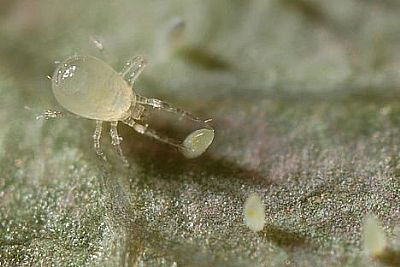LIMONICA / Amblydromalus limonicus (form. Typhlodromalus limonicus)
Predatory mite
Target
Use Limonica for biological pest control of the larvae of various species of thrips (first and second larval stages) and the eggs and larvae of greenhouse and cotton whitefly (all larval stages).
Packing
-
1000 ml bottle, containing 12,500 predatory mites (nymphs and adults) in millet husks, bran and sawdust
Dosage LIMONICA
|
|
Rate (ind./m2)
|
m2/ unit
|
Frequency
|
Interval (days)
|
Remarks
|
|
Preventive
|
50
|
250
|
1x
|
-
|
in sweet pepper, only
when pollen is present
|
|
Light curative
|
100
|
125
|
5x
|
7
|
start as soon as thrips
or whitefly is present
|
|
Heavy curative
|
250
|
50
|
3x
|
7
|
in cases of severe infestation
|
The information given below is merely indicative. Tailored advice can be provided if information is available on the local factors that need to be taken into account, such as the crop, the climate conditions and the level of infestation. For the correct approach, please consult a specialist of our company.
How does Limonica work
Adult predatory mites, nymphs and larvae hunt their prey or wait for it to pass by and then consume it. The mites also feed on pollen and various mite species. Use Limonica in a wide range of salad and ornamental crops, except tomato.
Application Limonica
-
Turn and shake bottle gently before use.
-
Carefully sprinkle material on leaves.
-
Make sure the material remains on the leaves for at least a few hours after introduction.
-
Do not carry out any work on the crop in the hours after releasing the predatory mites.
-
Aim for a minimum of 5,000 release points per hectare, evenly distributed over the total surface area.
-
Introduce Limonica when first signs of pest presence are observed.Precaution: application of this product can cause sensitization or allergic reactions, we therefore advise to take the necessary precautions.
Best working conditions Limonica
The predatory mite Amblydromalus limonicus is not susceptible to diapause, and can therefore be introduced at temperatures as low as 13°C
Handling
Biological beneficials have a very short life expectancy and therefore need to be introduced into the crop as soon as possible after receipt. Failure to do so can have a negative impact on their quality. In case you do need to store Limonica, please follow the instructions below.
Storage
-
After receipt: 1-2 days
-
Temperature: 12-14°C/54-57°F
-
In the dark
-
Provide ventilation to prevent CO2 accumulation
esticides can have (in)direct effects on biological solutions. Check here



 HellasSITES
HellasSITES